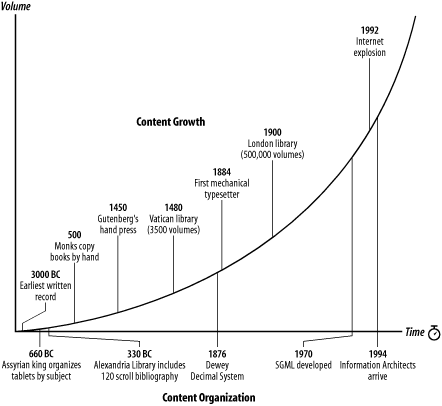WebReference.com - Part 1 of chapter 5 from Information Architecture for the World Wide Web, 2nd Edition. From O'Reilly (1/8).
[next] |
Information Architecture for the WWW, 2E. Chapter 5: Organization Systems
Challenges of Organizing Information
In recent years, increasing attention has been focused on the challenge of organizing information. Yet this challenge is not new. People have struggled with the difficulties of information organization for centuries. The field of librarianship has been largely devoted to the task of organizing and providing access to information. So why all the fuss now?
Believe it or not, we're all becoming librarians. This quiet yet powerful revolution is driven by the decentralizing force of the global Internet. Not long ago, the responsibility for labeling, organizing, and providing access to information fell squarely in the laps of librarians. These librarians spoke in strange languages about Dewey Decimal Classification and the Anglo-American Cataloging Rules. They classified, cataloged, and helped you find the information you needed.
As it grows, the Internet is forcing the responsibility for organizing information on more of us each day. How many corporate web sites exist today? How many personal home pages? What about tomorrow? As the Internet provides users with the freedom to publish information, it quietly burdens them with the responsibility to organize that information. New information technologies open the floodgates for exponential content growth, which creates a need for innovation in content organization.

Figure 5-1: Content growth drives innovation
And if you're not convinced that we're facing severe information-overload challenges, take a look at an excellent study[1] conducted at Berkeley. This study finds that the world produces between 1 and 2 exabytes of unique information per year. Given that an exabyte is a billion gigabytes (we're talking 18 zeros), this growing mountain of information should keep us all busy for a while.
As we struggle to meet these challenges, we unknowingly adopt the language of librarians. How should we label that content? Is there an existing classification scheme we can borrow? Who's going to catalog all of that information?
We're moving toward a world in which tremendous numbers of people publish and organize their own information. As we do so, the challenges inherent in organizing that information become more recognized and more important. Let's explore some of the reasons why organizing information in useful ways is so difficult.
1. [Back] "How Much Information?" is a study produced by the faculty and students at the School of Information Management and Systems at the University of California at Berkeley. See https://www.sims.berkeley.edu/research/projects/how-much-info/index.html.
[next] |
Created: September 23, 2002
Revised: September 23, 2002
URL: https://webreference.com/authoring/design/information/iawww/chap5/1/


 Find a programming school near you
Find a programming school near you